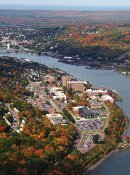Greg Corace

- PhD Forestry 2007
East of the dot-on-the-road town of Shingleton is a section of Highway M-28 known as the Seney Stretch. It is legendary among generations of Tech students, both for the stealthy state cops who patrol its twenty-five-mile length and for the bleak, swampy landscape it transects.
Few students speeding to their homes downstate along this gunshot-straight roadway know about the Seney National Wildlife Refuge. Bordering the Seney Stretch to the south, it is a picturesque haven for thousands of waterfowl. It is also the site of a bold experiment to return nature to the natural world.
Greg Corace ’07 wants to make one thing perfectly clear. Seney National Wildlife refuge is not about common loons, or bald eagles, or even those greeting-card gorgeous trumpeter swans.
For Corace, head of the refuge’s applied sciences program, Seney is about Seney, all 95,000 acres and everything within. Willows, weasels, and snapping turtles stand no less tall in his estimation than the showiest water birds. What matters is the place as a whole and the forces that created it.
Had he been an ancient Greek philosopher, Corace might have said that Seney was born of earth, wind, fire, and water. But he is a twenty-first century scientist with a PhD in Forest Science from Michigan Tech, so his list is slightly different.
“Fire and water shape this landscape,” he says. “Then beaver.” More recently, humans have had their way with the Seney marshes. Now Corace and others, many of them colleagues at Michigan Tech, are attempting to reweave the intricate net of natural processes that was ripped apart during the last century.
His work began about ten years ago, around the time fellow PhD graduate Charles Goebel ’01 joined him for a walk on the refuge. “I remember Charles turning to me while we were walking the pine islands in the Wilderness Area and saying,‘This is something special,’” says Corace. “That was about the time my superiors were saying they’d like to build a research program. “
I don’t think they knew what that meant.”
Excerpted from "Back to Nature" by Marcia Goodrich in the Spring Issue of Michigan Tech Magazine, Volume 50, Number 1